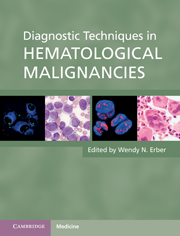Book contents
- Frontmatter
- Contents
- List of Contributors
- Preface
- Part 1 Diagnostic techniques
- Part 2 Hematological malignancies
- 6 The integrated approach to the diagnosis of hematological malignancies
- 7 Acute lymphoblastic leukemia
- 8 Acute myeloid leukemia
- 9 Mature B-cell leukemias
- 10 Mature T-cell and natural-killer cell leukemias
- 11 Lymphoma
- 12 Plasma cell neoplasms
- 13 Chronic myeloid leukemia
- 14 Myeloproliferative neoplasms
- 15 Myelodysplastic syndromes and myelodysplastic/myeloproliferative neoplasms
- Index
- References
15 - Myelodysplastic syndromes and myelodysplastic/myeloproliferative neoplasms
from Part 2 - Hematological malignancies
Published online by Cambridge University Press: 06 December 2010
- Frontmatter
- Contents
- List of Contributors
- Preface
- Part 1 Diagnostic techniques
- Part 2 Hematological malignancies
- 6 The integrated approach to the diagnosis of hematological malignancies
- 7 Acute lymphoblastic leukemia
- 8 Acute myeloid leukemia
- 9 Mature B-cell leukemias
- 10 Mature T-cell and natural-killer cell leukemias
- 11 Lymphoma
- 12 Plasma cell neoplasms
- 13 Chronic myeloid leukemia
- 14 Myeloproliferative neoplasms
- 15 Myelodysplastic syndromes and myelodysplastic/myeloproliferative neoplasms
- Index
- References
Summary
Myelodysplastic syndromes and myelodysplastic/myeloproliferative neoplasms
Myelodysplastic syndromes (MDS) are a group of clonal disorders of the hematopoietic stem cell (HSC) characterized by ineffective hematopoiesis. This leads to peripheral blood cytopenias, and an excess of marrow blast cells. In some cases this can progress to acute myeloid leukemia (AML). Myelodysplastic syndromes are thought to result from the accumulation of genetic or epigenetic lesions (such as promoter hypermethylation) initially in a very immature progenitor cell. This leads to a proliferative advantage of the MDS clone over normal immature progenitors. MDS lineage-committed progenitors display both abnormal terminal differentiation and an increased susceptibility to apoptosis. These two features explain the clinical consequences of blast cell accumulation and peripheral blood cytopenias.
The diagnosis of MDS is generally suggested by the presence of peripheral blood (PB) cytopenias. However, the diagnosis requires the integration of the blood manifestations with the clinical history and physical examination. Although the etiology of MDS is generally unknown, antecedent cytotoxic therapy or radiation exposure and congenital bone marrow failure syndromes can predispose to MDS. Physical examination is in general normal in MDS, while splenomegaly can be found in myelodysplastic/myeloproliferative neoplasms (MDS/MPN). Careful morphological review of bone marrow for dysplasia is central to the diagnosis of MDS and MDS/MPN, and cytogenetic analysis for prognosis. Molecular genetics and flow cytometry assays are under evaluation, and, in future, may provide information for further refinement of the prognosis. The specific features of each of these diagnostic modalities will be discussed.
- Type
- Chapter
- Information
- Diagnostic Techniques in Hematological Malignancies , pp. 307 - 328Publisher: Cambridge University PressPrint publication year: 2010



